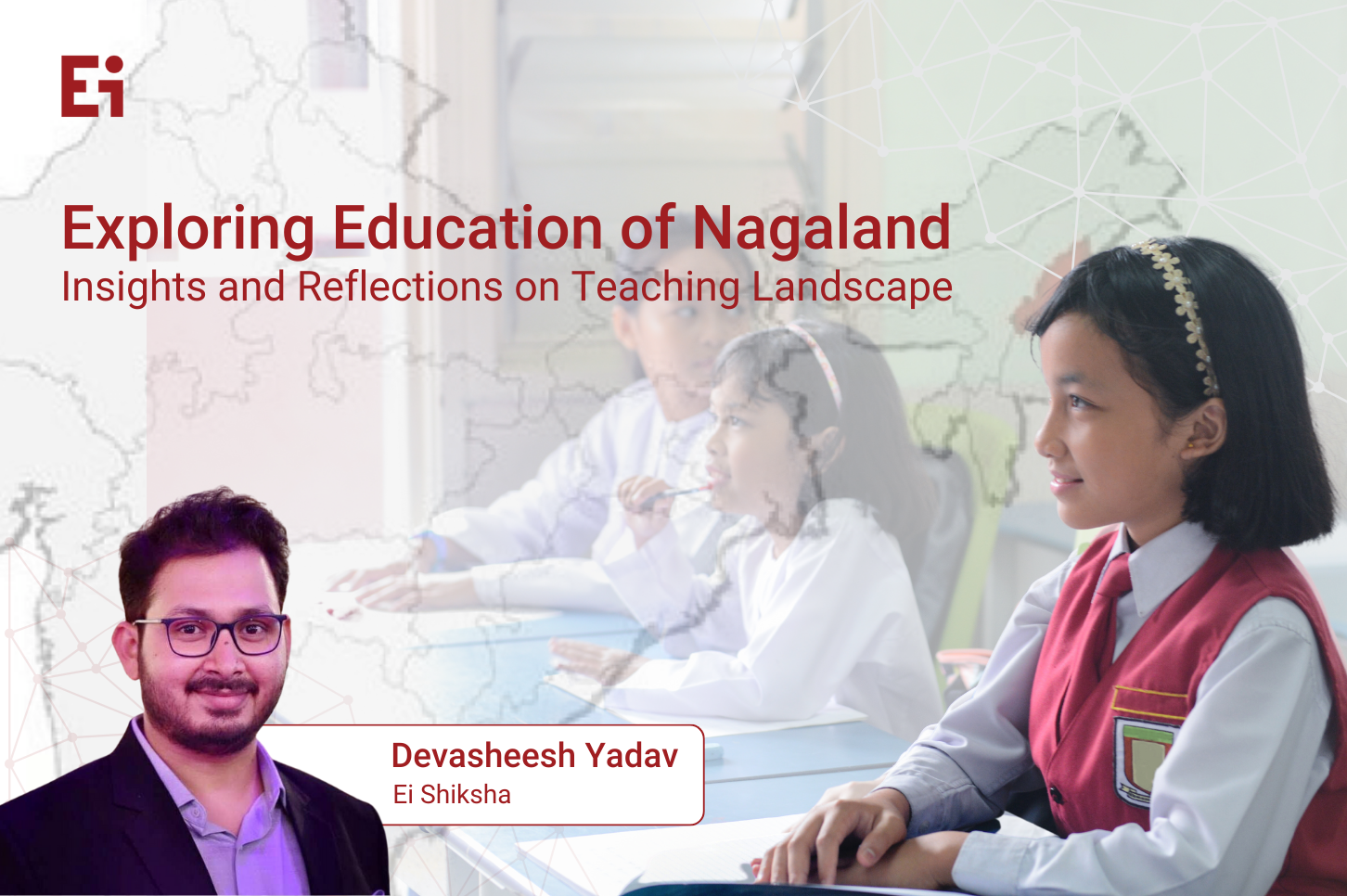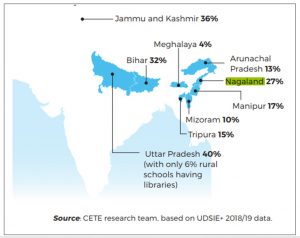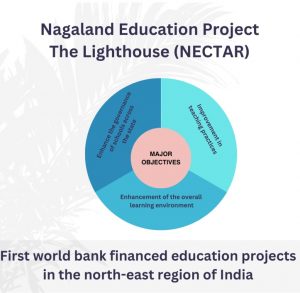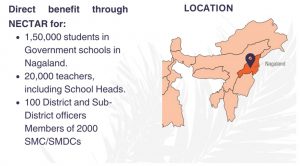Exploring Education of Nagaland: Insights and Reflections on Teaching Landscape
My year kicked off in January 2023 with a capacity building workshop for teachers of the Nagaland Board of State Education (NBSE). The workshop focused on the “Art and Science of Question Making” and aimed to equip teachers with the skills to craft good questions.
During the breaks, I looked forward to the opportunity to speak more with the experienced and knowledgeable teachers in attendance. I relished the chance to soak up their expertise and learn more about their experiences in the education system of Nagaland. Having never lived in the hills before and never been exposed to such a rich and diverse culture all in one place, I was keen to understand how their daily lives unfolded, how they managed their time and responsibilities, and what factors influenced their strong drive to educate. Furthermore, I was intrigued to learn about the goals they had for their students and the aspirations they held for their educational journeys. Having lived my entire life in Uttar Pradesh, this was an opportunity for me to gain insights into the unique perspectives and experiences of these educators in a new state.
Challenges Faced by Teachers in Nagaland:
During my conversations with the teachers, I couldn’t help but notice the unwavering passion and immense dedication they had towards their work. Despite the challenges they faced, they remained committed to their students’ success. Their insights gave me a deeper appreciation of the critical role teachers play in shaping the lives of their students. The shortage of qualified teachers in Nagaland, particularly in remote areas, has resulted in a high teacher-pupil ratio. The UNESCO’s recent ‘The State of Education for India – 2021’ report, highlights the fact that state of Nagaland has 413 vacant positions for teaching staff which makes up to 37% of rural teaching staff requirement. It also highlights the need for infrastructural development – factors such as availability of drinking water and libraries in school are emphasized. (Figure 1 illustrates the percentage wise representation of some states with lower availability of libraries in the school vis-à-vis Nagaland.) This puts a lot of pressure on schools and reduces the effectiveness of classroom learning. This shortage of teachers also affects the building of a conducive environment for learning, which is essential for the overall development of students.
Government Initiatives and the Importance of Teacher Training:
Nagaland as a state has a strong emphasis on education, with a literacy rate of around 80%, higher than the national average. The state has implemented a number of initiatives to improve education indicators. In 2021, it launched including an initiative known as the Nagaland Education Project – The Lighthouse – Nagaland Enhancing Classroom Teaching and Resources (NECTAR) which has been developed with the objective of enhancing the quality of education and improving learning outcomes in government schools throughout Nagaland. This project, funded by the World Bank (WB), marks the first instance of a WB-financed education initiative being implemented directly by a state government in the north-eastern region of India. Its primary focus is to uplift and empower the education system in Nagaland, ultimately benefiting students and educators alike.
Through my engagement in the workshop, I realised one of the key challenges needed to be addressed by NECTAR, would be to ensure that students are equipped with the skills and knowledge needed to succeed in the 21st century. This requires attention is teacher training, particularly in terms of focusing on the softer outcomes of capacity building.
When teachers receive proper training and support, they can become more effective in their role and provide quality education to their students.
Research has revealed that the implementation of professional development activities, which prioritize understanding how students learn and employ teaching methods that enhance learning, has proven to be highly effective in enhancing teachers’ knowledge and effectiveness (Ingvarson, Meiers, & Beavis, 2005). Similarly, studies have shown that providing training and technical support to teachers is one of the key factors in improving the effectiveness of prevention and intervention programs.
The benefits of such support include increased preparedness for new tasks, mastery of specific skills, and a boost in teachers’ confidence and belief in their own abilities (Durlak & DuPre, 2008; Kyriakides et al., 2014). Witnessing their students’ success motivates teachers to continue their efforts and improve their teaching skills. This, in turn, can attract more people to take up teaching as a profession, thus addressing the issue of teacher shortage in the long run.
Furthermore, teachers who have a mindset of building the future of the state can be powerful agents of change in improving the education system. By focusing on the softer outcomes of teacher training, such as building positive relationships with students, fostering a growth mindset, and promoting critical thinking, teachers can create a more engaging and empowering learning experience for their students, regardless of the lack of resources or the challenging environment.
Teacher training or capacity building programs can have some soft or intangible outcomes that may not be immediately measurable but are nonetheless important for the success of the program. Here are a few examples:
- Improved teacher confidence: One of the main goals of teacher training is to improve teacher knowledge and skills. As a result, teachers may feel more confident in their abilities to effectively teach their students. This improved confidence can lead to better job satisfaction and a more positive attitude towards teaching.
(Lin Gu & Spiros Papageorgiou).
- Increased teacher motivation: Teacher training programs can also help to increase teacher motivation by providing them with new teaching strategies and tools that can make their work more engaging and rewarding. This increased motivation can translate to improved student outcomes.
- Strengthened teacher relationships: Teacher training programs can bring teachers together and provide them with opportunities to collaborate and share ideas. This can lead to stronger relationships between teachers, which can improve the overall school climate and culture.
- Improved teacher retention: Teacher training programs can also help to improve teacher retention rates by providing teachers with the support they need to succeed in their roles. When teachers feel valued and supported, they are more likely to stay in their jobs and contribute to the long-term success of the school. (Galit C. Reitman & Belinda Dunnick Karge)
- Increased community involvement: Teacher training programs can also help to increase community involvement in education. By providing teachers with the skills and knowledge they need to engage with parents and community members, they can build stronger relationships with these groups and improve the overall quality of education in the community.
Promoting Girls’ Education through Teacher Education:
Female participation in education in Nagaland has been steadily improving over the years, although there are still significant gender disparities that need to be addressed. Historically, girls in Nagaland have faced several barriers to accessing education, including poverty, cultural beliefs, and traditional gender roles.
However, the government of Nagaland has implemented multiple policies and initiatives to promote girls’ education and increase their enrollment and retention rates in schools. For example, the state government provides scholarships and incentives for girls from marginalized communities, as well as for those who perform well academically.
As a result of these efforts, the gender gap in enrollment rates has been narrowing in recent years. According to the District Information System for Education (DISE) report for Nagaland 2019-20, the overall enrollment ratio for girls was 48.2%, which is slightly lower than the enrollment ratio for boys (51.8%). However, at the primary level, the enrollment ratio for girls was slightly higher than for boys, indicating that more girls are now enrolling in school at a younger age. But if we look at the secondary level and above, this gap keeps on increasing.
- Existing challenges
Despite all the gains, there are still significant challenges to be addressed in terms of improving the quality of education for girls and ensuring that they have equal access to educational opportunities. Cultural beliefs and traditional gender roles continue to pose barriers to girls’ education in some parts of Nagaland, particularly in rural areas. The patriarchal social conditioning of a female child is also a challenge, leading to a woman growing up with limited awareness of her rights and importance of education in her life. In Nagaland, a concerning gender disparity in workforce participation is evident, especially in urban areas. Rural regions show a participation rate of 52.3% for females, while urban centers lag at 25.9%. Census data from 2011 emphasizes the need for targeted action. Education promotion emerges as a vital solution; enhancing education can positively impact female workforce engagement. Male participation stands at 53.4%, contrasting with 44.7% for females. While there is some parity in rural sectors (55% male, 52% female), urban areas depict a gap (47% male, 25% female). Districts like Mon, Zunheboto, Longleng, and Peren excel in rural female workforce engagement, with Peren leading urban female labor participation. To bridge this gap, comprehensive strategies integrating education and accessible work opportunities are crucial. This synergy can redefine Nagaland’s narrative, fostering gender equity and economic growth.
Additionally, there is a need for continued efforts to improve the quality of education in general, as well as to address the shortage of qualified female teachers in some schools.
- Effect of female workforce in education
Increasing the representation of female teachers in schools in Nagaland can have several positive effects on the learning outcomes of students. Firstly, it can provide more role models for girls and encourage them to stay in school, especially in areas where girls’ education is not given as much importance. This can help to bridge the gender gap in education and ensure that girls are able to access the same educational opportunities as boys.
Secondly, having a diverse teaching staff can help to build a more inclusive and supportive learning environment for all students, especially those from marginalized communities. Female teachers may be better equipped to understand and address the unique challenges faced by girls and other vulnerable groups of students.
Overall, these soft outcomes of teacher training and capacity building programs are important to consider when evaluating the effectiveness of these programs. While they may not be immediately measurable, they can have a significant impact on the success of individual teachers and schools.
Looking around the word:
Many countries worldwide have implemented effective strategies to improve teacher learning and teaching practices, deserving recognition. These exemplary approaches offer valuable insights into enhancing the quality of education on a global scale.
Thoughtful professional development initiatives have been instrumental in fostering a culture of collaborative learning among teachers. By promoting inter-school and inter-university knowledge exchange, countries such as Singapore, Australia, Canada, and Finland have enabled educators to learn from one another and share best practices, thereby strengthening the teaching profession as a whole. (Linda Darling-Hammond & Ann Lieberman, Stanford University)(Linda Darling-Hammond & Ann Lieberman, Stanford University)
Emphasizing profession-wide capacity building has yielded fruitful outcomes. Noteworthy efforts in Ontario (Canada) and Singapore have created platforms for wide sharing of research and successful practices. These initiatives recognize exemplary classroom and school achievements, empowering expert teachers and principals to provide system-wide leadership. Finland, Singapore, Canada, and Australia have successfully attracted top talent by offering competitive salaries and financial subsidies, ensuring the programs’ excellence and standardization.
Meaningful and relevant coursework and the integration of clinical experiences in conducive settings have proven to be impactful in bridging the gap between theory and practice. Finland, Canada, Australia, and the United States have pioneered this approach, enabling aspiring teachers to apply their knowledge in real-world classroom contexts.
The utilization of professional teaching standards has been instrumental in elevating educational practices. By aligning teaching with student learning outcomes, countries such as the United States, Australia, Canada, and Singapore have fostered continuous improvement and evaluation. Teacher performance assessments based on these standards have contributed to both candidate competence and overall program enhancement.
The impact of our Workshop
While the 4-day workshop focused on imparting specific skills, I realized it was having a broader impact. It was creating a sense of community among the teachers and building bridges between educators from different parts of the state. It was a reminder that learning, and growth are not just about acquiring new knowledge or skills but also about building relationships and fostering connections.
Andreas Schleicher in his book ‘World Class’ mentions how numerous countries have recognized the importance of investing in teacher professional development. In Singapore, for instance, teachers are provided with 100 hours of professional development annually to ensure their knowledge and practices remain current and refined. Teacher networks and professional learning communities actively promote collaborative learning among peers. Singapore also established an academy to foster a culture of continuous improvement. Encouraging teachers to consistently exchange and share best practices with one another.
As the training progressed, I could see a change in the teachers’ demeanour. They appeared more confident in their abilities to effectively teach their students. Their eagerness to learn and apply the new techniques was palpable. During the interactive sessions, they were more forthcoming with their opinions and ideas, and I could see that they were motivated to implement the new strategies in their classrooms.
To harness the right potential of teachers in Nagaland and even in the country, the policy makers may look towards:
- Pre-service training coupled with real-time access to some of the selected schools of the state.
- Deciding minimum number of engagement hours for professional skill development which should be continuous and driven by feedback can be a good way to reform the existing practices.
- Research and development led by actual teachers working on ground should be promoted.
- Creating more avenues to do collaborative activities where teachers get an opportunity to discuss and demonstrate the best practices.
Conclusion:
Through conversations with experienced educators, it becomes evident that the challenges faced by Nagaland’s education system are multifaceted, including teacher shortages, gender disparities, and infrastructural limitations. Government initiatives like the Nagaland Education Project – NECTAR – have initiated positive strides towards improving the quality of education by enhancing teacher training and focusing on learning outcomes.
Drawing inspiration from successful models worldwide, particularly in countries like Singapore, Australia, Canada, and Finland, can provide valuable insights. Collaborative learning, mentorship, research dissemination, and adherence to professional teaching standards can foster a culture of continuous improvement in education.
Therefore, to further elevate education in Nagaland, it is recommended that:
- Investment in Teacher Training: Strengthen efforts in teacher training programs that address not only technical skills but also the softer outcomes of teacher confidence, motivation, and relationship-building.
- Promotion of Collaboration: Create platforms that encourage collaboration among educators from different regions and backgrounds, fostering a sense of community and shared learning.
- Address Gender Disparities: Implement strategies to promote girls’ education by providing scholarships, incentives, and supportive environments that challenge traditional gender norms.
- Infrastructure Development: Prioritize infrastructural development in schools, ensuring access to essential facilities such as drinking water and libraries, which play a crucial role in effective learning.
- Long-term Vision: Align initiatives like NECTAR with a comprehensive, long-term vision that addresses the intricate needs of the education landscape in Nagaland.
The implementation of these promising strategies in countries worldwide demonstrates their potential to enhance teacher learning and teaching practices. By promoting collaborative learning, mentorship, research dissemination, and the recognition of successful practices, these approaches contribute to the overall improvement of the education system.
The quest of comprehensive development entails traversing an arduous path, one that necessitates a deliberate alignment of endeavours towards discernible outcomes. In this regard, it becomes imperative for our states to conceive and orchestrate a multitude of programs that are attuned to the multifarious needs inherent in our diverse landscape, all while ensuring their strategic design caters to the pursuit of sustainable long-term progress. I am hopeful as NECTAR moves into its next years; it will have a more broad-based impact on some of these issues.
After all, the future belongs to those who envision tailored programs to address the intricate tapestry of their society’s needs, guiding long-term development with precision and purpose.









